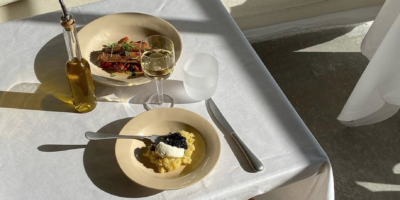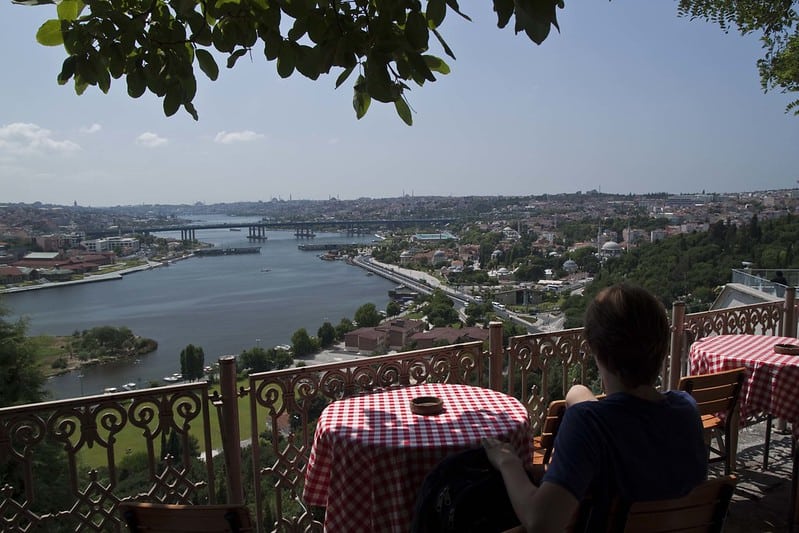A Brief Guide to Turkish Tea Culture
For a country known for its world-famous strong black coffee, it’s surprising when one learns that tea or Çay (pronounced the same way as Indian ‘chai’) is equally popular! So popular, in fact, that Turkey tops the list for consumption per capital.
The root word for tea comes from Mandarin – “cha”. Due to the Silk Road, it travelled from Central Asia to the Middle East and Anatolia. As such, you can find the words “çay” or “chai” or any variations of the word in this huge geographical area.
The country produces tea entirely for domestic consumption. There are even rumours that tea is being imported from China and other countries. It can’t catch up with the local demand! It might be surprising to know that Turkey is the world’s sixth-largest producer of tea. Its importance in Turkish culture cannot be underestimated, even if it’s a fairly new drink when compared to the long history of coffee. It’s typically served in tulip-shaped glasses and brewed for a long while before being served.
It is difficult to imagine social events in Turkey without tea. All kinds of ceremonies and celebrations involve tea. It’s an integral part of the fabric of society in Turkey. It’s not just a drink to wake up, Turkish tea is a tradition tied in with the society’s hospitality. A cup of tea is an offering to anyone, friends, guests and even strangers and in all kinds of places!
History
Surprisingly, tea production and consumption in Turkey is relatively new when compared to the popularity of coffee. The Ottomans were familiar with tea since the 16th century, the drink only gained popularity in the 19th and 20th century. The Ottoman Sultan Abdulhamid tried to plant the initial seeds in Bursa, apparently, but the climate wasn’t very suitable. And coffee from the Arabian peninsula was relatively expensive. Later, the first cultivation was on the Aegean and Marmara Region near the two seas with success only happen along the coast of the Black Sea region. Today, Rize and Artvin are known for the tea cultivation given their moderate and rainy climate that helped bring tea’s presence in the country.
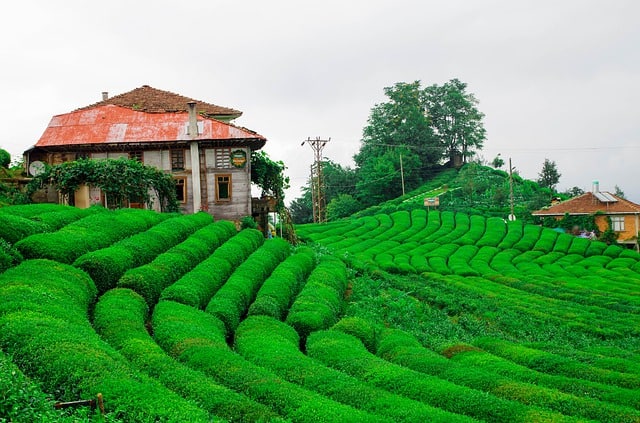
Tea Plantations in Rize, Turkey. Image by yusuf kazancı from Pixabay
After the formation of the Republic of Turkey, the first president and founder of Turkey, Atatürk, needed an alternative to the high costs of tea and worked towards making tea more accessible by trying production in different parts of the country. In Rize, tons of tea was planted in 1930 and it flourished. Today, Rize, Cayeli and Artvin are known for the tea cultivation given their moderate and rainy climate that helped solidify tea’s presence in the country. After a few solid decades of import and challenges, tea production flourished and established tea’s presence including increase in demands and supply eventually followed.
After WW1 and the loss of the Arabian Peninsula and as a result, access to coffee waned. Tea, then, became the beverage for the masses. Second World War, tea consumption tripled and the Turkish tea industry thrived. It also helped that was cheap to produce and consume and less expensive when compared to coffee. Even Ataturk, the first President and hero of the War of Independence encouraged tea drinking because it was tied directly to the local economy.
Today, it’s impossible to imagine a visit to Istanbul and even the remotest parts of the country without a cup of tea, usually poured in a beautiful glass cup!
Turkish Tea Cups and Samovar
When one thinks of Turkish tea, you imagine drinking it out of the elegant and delicate tulip-shaped glasses, without a handle. They’re known as ince belli (slim waisted or slender), or otherwise, tulip-shaped (Tulips originate from Anatolia) in Turkish. Small decorated saucers accompany them in most restaurants, sea-side make-shift tea stalls and cafes throughout the country. Tea is drunk piping hot and the drinker holds the cup delicately gripping the rim of these slender cups. Avoid getting burnt by using the saucer to put it down if it gets too hot to handle!
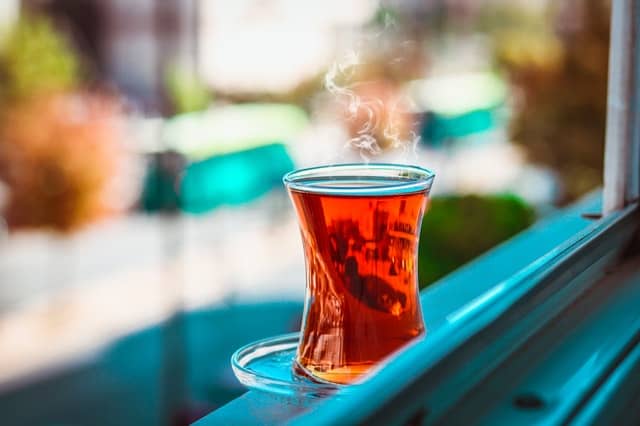
Photo by Hasan Albari from Pexels
There’s even some interesting history as to the beginning of ince belli cups. From the late 1850s and 1900s onwards, European style tea cups for black tea were replaced because of economic reasons and industrialization. Moreover, the Turkish glass industry (started in a Beykoz glass factory) became to develop and tea glasses were manufactured for the local economy. Preference over thick glass and its higher cost made it possible for smaller, cheaper and thinner glasses to be manufactured. However, there’s not an exact time given for the design of these kinds of glasses. There was a painting done by painter Hodja Ali Rıza (lived between 1858-1930), that featured an ince belli tea cup.
The Turkish double teapot is called a Çaydanlik and quite similar to a Russian-style samovar. However, it’s more streamlined and are available in glass, stainless steels and even durable plastic! Even modern versions are now all the rage in the country. These newer versions even have tech involved – it speaks to you when the tea is ready!
Tea is freshly brewed in this special double teapot and allowed to “sit” for a while. This kind of teapot is similar to a samovar (called semaver in Turkish), with a kettle at the bottom and the infuser at the top. The brew with black tea leaves, usually with bergamot (citrus bergamia) flavour, unfurls and infuses in the water thoroughly before being poured. The concentrated tea has a red-mahogany colour.

Photo by Musa Ortaç from Pexels
First, the infused tea is poured and then topped with hot water. This way, the tea can then be consumed strong, mildly strong, or weak depending on what the drinker desires at that moment. The drinker can add more or less water depending on their preference and taste. For a stronger brew, you can have it dark (koyu) or light (açik). People mostly prefer a colour between the two, similar to rabbit’s blood (tavşan kani). It’s an entirely different way of brewing tea instead of the tea bag method or the Indian method with boiled milk. Unlike other country’s teas, milk is never added. However, sugar cubes are generally served and in winter, sometimes lemon as well.
Turkish Tea Culture
Tourists to Turkey are bound to see the beverage everywhere – street corners, in shops or on trays being carried around the Grand Bazaar in Istanbul. Simply put, tea is a nonnegotiable part of and parcel of life in Turkey – its presence is constant.
Tea is served for all occasions, celebrations or funerals or for pleasure or in work meetings. You can find that shop keepers, even hairdressers offer tea to their customers even if you have or haven’t made a purchase. It’s a symbol of generosity, hospital and general, good will on behalf of the host.

Image by Yunus KARA from Pixabay
Tea time is simply time to take a pause from the hustle and bustle of life, in whatever form or fashion, and simply have some heartfelt conversations and exchanges with the other party. This is needed especially in such a bustling city which never stops, like Istanbul. Here, one can find picturesque tea gardens in secret spots that serve as respite from the chaos of the city. Grab a book or take a breather in the many tea gardens or tea cafes around the city and you will feel more energized and ready to tackle the next item on your travel itinerary. Alternatively, pause for a break and observe the everyday people of the city.
In Turkey, you can also find many fancy herbal teas that are dried and used in the cold winter months. For example, you can try chamomile, St. john’s wort, sage tea, rosehip tea and linden flower tea – which are the most popular ones and known for their healing properties. Sage tea with lemon is good for sore throats, linden flower helps relaxes you and st. john’s wort and chamomile helps you sleep better. In the winter months, you can find local markets selling these and many more varieties that come under the umbrella of “Kış çaylar” or winter teas. Get some of these different teas at the Egyptian Spice Bazaar. Learn all about it here in article: The Best Markets and Bazaars in Istanbul.
Turkish Tea Gardens
Tea gardens called Çay Bahceşi in Turkish are secret spots throughout the cities and towns where people of all social classes come together. They gather here, especially in Istanbul, with usually a view of the Golden Horn or the Bosphorus waterway, to enjoy hot piping tea in tulip-shaped glasses.
Weekends are busy affairs in these places but they’re informal places where you can spend the entire day sipping hot tea and enjoy conversations into the late hours of the night, or spend quality alone time with a book. Plus, it helps when the atmosphere is informal but warm and cozy. Waiters take your orders and bring your orders in a jiffy.
One of the best spots is Pierre Loti hills and its cafes. Named after a French naval officer who spent time in the city, the hill is in one of those secretly charming places in the city. Not many spots in the city offer this particular view of the Golden Horn. It’s also not fully accessible and in a remote part of town, albeit served by buses or taxis. Nonetheless, a cable car makes it easier to go up so you spend your time gazing at the city below, seated at one of the many cafes perched atop the hill. Make a day trip out, venture into the neighbourhood and even further away to other popular neighbourhoods, Eyüp and Balat.
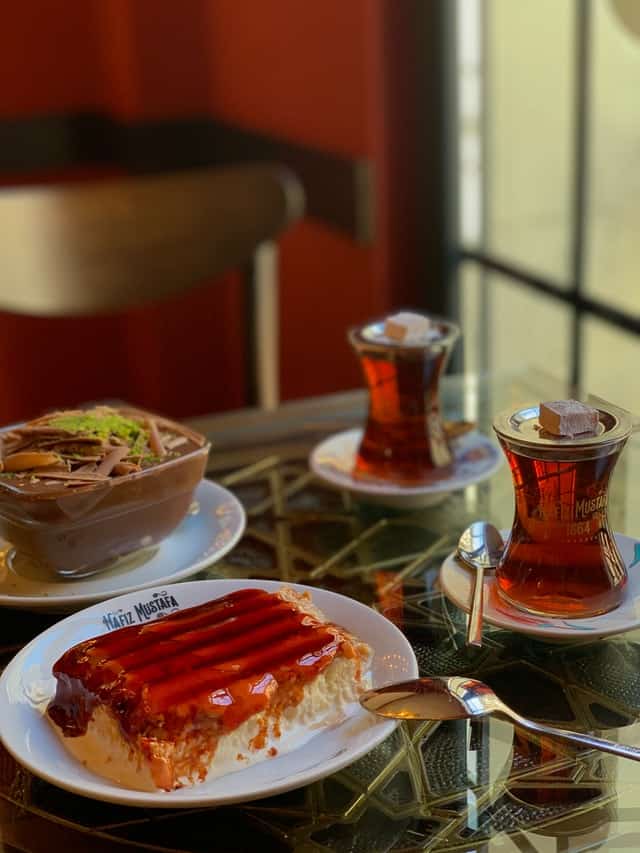
Photo by Büşra Yaman from Pexels
In more busy areas such as Eminönü, you have to try Turkish tea at Hafiz Mustafa, one of Istanbul’s gourmet sweetshops, and its array of desserts. You can find Turkish Trilece, a milk pudding and chocolate pudding, as pictured above, and many more traditional and modern sweets to enjoy with your tea!
Turkish Tea at Home
Similar to Eastern and Asian cultures, hospitality is a given in Turkish culture and tea and coffee plays central roles for at-home hospitality.
A freshly brewed cup of tea in an at-home Çaydanlik is offered to all guests. Tea is typically served with cookies/biscuits called Kurabiye or sweets/desserts such as Lokum and Baklava. Read more about the Top 10 Turkish Desserts – don’t miss out! There’s an abundance of tastes as far as cookies go, but you should definitely try the ones with tahini, poppy seeds or with sesame seeds in a donut shape called Kandil simiti/kurabiyesi. Of course, there’s also a crunchy one called Çay kurabiyesi that you can use to dip your tea in and have a bite!
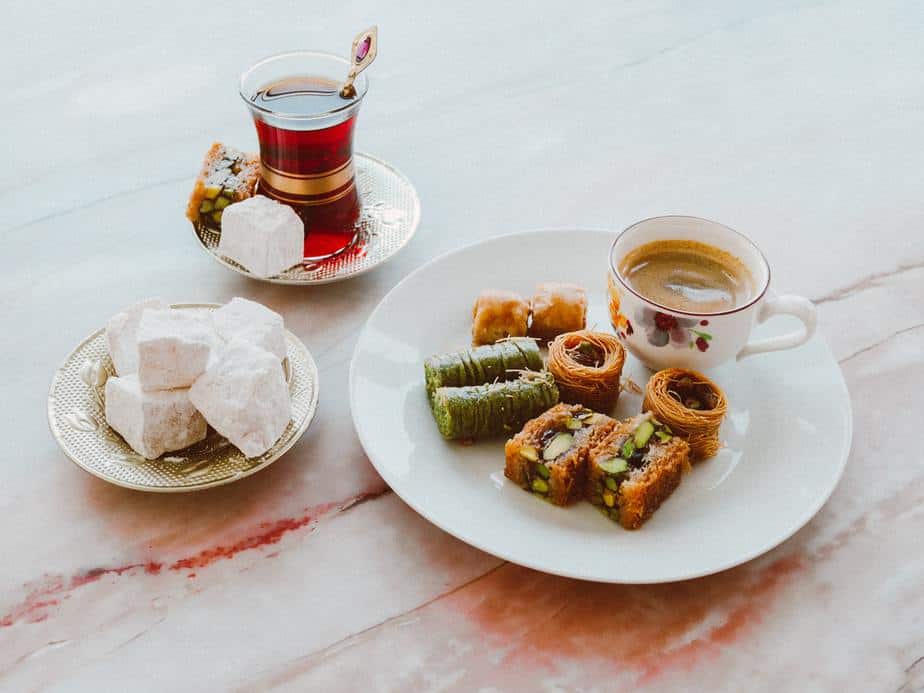
Photo by Lisa from Pexels
Turkish Tea in the News
Tea is so important to the country, that Rize’s Trade Bureau sometimes even organizes the Best Tea Brewing contest. Rize is known as the Tea Capital of Turkey! In more recent news, there’s even a building that’s been made into the famous Turkish tea cup and the developers have applied to include this in the Guinness Book of World Records, as the world’s biggest Turkish tea cup! Hilarious!
Companies like Çaykur is the largest tea producer in the country! Recently, they have even started exporting green tea to other countries such as the USA. Try some of their teas by venturing into a local shop or supermarket and finding their bags. Find their different teas in the local supermarkets. Alternatively, you can try brands such as local brands Beta, Doğadan and Doğuş and international ones such as Lipton, Ahmad’s Tea and Twinnings in some speciality food stores.
Even with its more recent history when compared to coffee’s long history, tea symbolizes sincere exchanges and even meaningful pause in a busy life. This makes tea a universal beverage, similar to Turkish coffee. From its unique tea culture and preparation, its distinct glasses and tea spaces, a trip to Turkey is never complete without trying its tea and taking some back as a souvenir. Read our article on what would make a good gift in our article about Great Gift ideas from Istanbul.
Planning a trip to Paris ? Get ready !
These are Amazon’s best-selling travel products that you may need for coming to Paris.
Bookstore
- The best travel book : Rick Steves – Paris 2023 – Learn more here
- Fodor’s Paris 2024 – Learn more here
Travel Gear
- Venture Pal Lightweight Backpack – Learn more here
- Samsonite Winfield 2 28″ Luggage – Learn more here
- Swig Savvy’s Stainless Steel Insulated Water Bottle – Learn more here
Check Amazon’s best-seller list for the most popular travel accessories. We sometimes read this list just to find out what new travel products people are buying.




